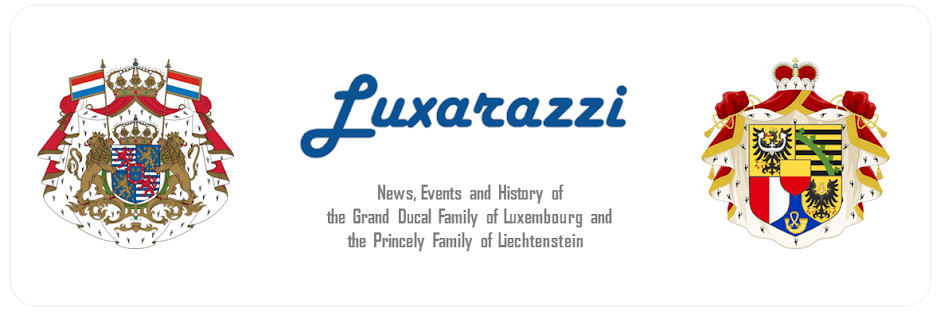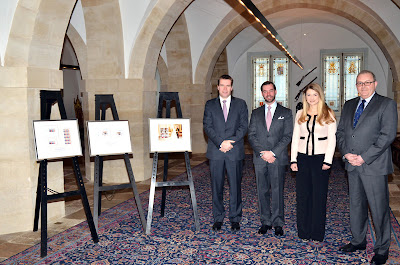Before the wedding of Archduke Christoph and his now wife, née Adélaïde Drapé-Frisch, kicked off, the couple paid respects to the archduke's ancestor by visiting
Église des Cordeliers. Accompanied by Archduke Carl-Christian and Archduchess Marie-Astrid as well as the bride's parents, the couple went to the church for prayers and a time of contemplation at the tombs of
the Dukes of Lorraine. Adélaïde also laid down a bouquet of flowers at the tombs.
 |
| Photo: AFP / Jean-Christophe Verhaegen |
At 5pm the same day, the couple and close family members made their way to the
Hôtel de Ville of Nancy for the civil wedding. The ceremony was officiated by the mayor of the town, André Rossinot. After they formally tied the knot, the couple appeared on the balcony of the town hall to greet the onlookers; they were joined by a few family members like Archduke Christoph's godfather Grand Duke Henri and Grand Duchess Maria-Teresa.
The next day, on December 29th, the big day finally arrived. The couple who has known each other since about five years, when they met during their sabbatical years at
Jeunesse Lumière, a
school of prayer and evangelisation related to Charismatic Renewal, had
chosen the Basilique Saint-Epvre as the locality for their wedding. At about 10pm the church was opened so that locals could enter as they would allowed to participate in the church wedding. A little while later
a very royal set of guests started to arrive for the religious wedding of Archduke Christoph and Adélaïde Drapé-Frisch.
 |
| Photo: L'Est Républicain / Pierre Mathis |
After all the guests had arrived, the groom's father Archduke Carl-Christian arrived together with the bride's mother, Odile Drapé-Frisch; next up were Archduke Christoph and his mother née Princess Marie-Astrid of Luxembourg and finally the bride arrived together with her father Philippe Drape-Frisch, a diplomat and currently posted as the second advisor to France's ambassador to Saudi Arabia, in a Daimler owned by the Grand Ducal family.
The bride wore a duchess satin gown made by Parisian designer Diane Lelys that included a five meter long train, a fur-trimmed jacket and a lace-y overlay underneath. The work on the dress had already started back in April, when the bride and the designer met through friends of the Drapé-Frisch family.
Adélaïde topped of her look with an antique veil now belonging to the Habsburg family. There are quite a few stories where this piece of
Alençon lace originated from and how it ended up in the hands of this branch of the family.
The veil is often described as a heirloom piece that was originally used for the cradle of Napoleon II (1811 - 1832), son of of
Emperor Napoleon I of the French and Archduchess Marie Louise of
Austria. It was then worn by Empress Eugénie for her wedding to Napoleon
III in 1853. After that, we pretty much lose track of the veil for more than 100 years. At some point in history it was given to Archduchess Yolande, the groom's grandmother and a born princess of Ligne, who then lent it to her granddaughter Marie-Christine as well as Kathleen and Adélaïde for their weddings.
 |
| Photo: L'Est Républicain / Pierre Mathis |
Additionally, she wore the same diamond tiara that the groom's sister Archduchess Marie-Christine wore for her wedding a few years ago. Interesting fact: it is said that the bride was accompanied by a bodyguard when she went to the hairdresser whose sole purpose it was to keep an eye on the tiara.
The religious ceremony was headed by the bishop of Nancy and Toul Jean-Louis Papin, who was joined by no less than sixteen concelebrants, twenty-seven altar servers and two choirboys. The service lasted for about two hours. The music was provided by the organist of the basilica, a capella group Voxpop and a choir from
Philanthropos, a school that was attended by both the bride and the groom.
Archduke Christoph chose five witnesses, his brother Archduke Imre
and his cousin Prince Louis, as well as three friends, Augustin Duranso,
Loïc de Framond and Stanislas Godemel, who also did the first reading from the Book of Genesis.
The second reading, this time taken from the Epistle to the Corinthians, was given by the groom's sister Archduchess
Marie-Christine.
Archduchess Adélaïde's witnesses were
her sister Laetitia, her cousin Anne-Cécile Le Bihan and two friends of
her's, Cécile de Framond and Anne-Emmanuelle Loriquet. Her other sister
Alienor acted as her bridesmaid.
The bridal party was
made up of two cousins of the groom, Princess Nora of Auersperg-Trautson,
daughter of his father's sister Archduchess Constanza, and Prince Jean
de Nassau, youngest child of Prince Guillaume and Princess Sibilla of
Luxembourg. In addition two children of Christoph's cousins: Prince
Noah de Nassau, younger son of Prince Louis and his wife Princess Tessy,
and Archduchess Zita of Austria, daughter of Archduke Carl-Christian
and Archduchess Estelle. Also included was the groom's little nephew,
son of his sister Marie-Christine, Count Léopold de Limburg-Stirum. The
names of the other members of the bridal party were Jeanne Drapé, Agathe Drapé and
Maximilien.
 |
| Photo: L'Est Républicain / Pierre Mathis |
German magazine Bunte describes the mood in the church and throughout the whole wedding as being similar to that at the wedding of Crown Princess Victoria of Sweden and Prince Daniel. During the church service also Christmas songs, such as Adeste fidelis, were sung.
When the couple left the church after the religious ceremony was over, they were greeted by cheering crowds. They then made their way to the
Hôtel de Ville where they appeared on the balcony to greet the crowds and the almost obligatory kiss. Afterwards a reception was held at the townhall.
In the evening, a gala dinner was held at the
Grand Hôtel de la Reine opposite of
Place Stanislas, where all the guests also stayed during the night.
More guests including Prince Charles-Louis de Merode and his wife Prince Clotilde, as well as Katarina Esteve, daughter of Grand Duchess Maria Teresa's sister Catalina. All the cousins on both sides of the children of the grand ducal couple are very close and often refer to each other as cousins even though they are not technically related.
A special mention to Valentin Dupont from
the Royalement Blog for providing some of the information!!





















